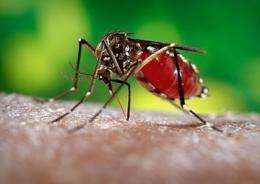Human Movement Plays Critical Role in Disease Transmission

To control mosquito-borne diseases like dengue, researchers need to look at the behavior of people, not just the insect that transmits the disease, according to new research by Steven Stoddard of the University of California, Davis, and intercollegiate colleagues. The study, published July 21 in the open-access journal PLoS Neglected Tropical Diseases, exhibits work by an international, multidisciplinary team of vector biologists, sociologists and virologists studying dengue in Iquitos, Peru.
Understanding the behavior of the host and vector can lead to better surveillance and intervention and improved disease prevention, said Stoddard. The incidence rate of dengue in Iquitos has varied from around five percent to over 30 percent after new virus serotype introductions, according to Stoddard. There is no vaccine and no cure for dengue, which is transmitted by the tiger-striped, day-biting mosquito, Aedes aegypti.
To track individual human movement, the research team uses satellite-based global positioning system (GPS) and culturally-sensitive interviews that were developed by the team.
"We do not necessarily expect to be able to identify actual places or individuals where the risk is greatest because the population dynamics of the vector and the behavior of the hosts are too transient," Stoddard said. "We do hope, however, to arrive at a much better understanding of the mechanics of transmission—like why epidemics occur even when vector abundances are low—and of the types of places and types of individuals at greatest risk."
The researchers developed a conceptual model showing that the relevance of human movement at a particular scale depends on vector behavior. Focusing on Aedes aegypti, they illustrated how vector-biting behavior combined with fine-scale movements of individual humans engaged in daily routines can influence transmission. They also outlined several considerations for designing epidemiological studies to encourage studies of individual human movement.
"We hope to arrive at a better notion of the spatial scale on which dengue transmission occurs and from an operational standpoint, at what scale to focus interventions," Stoddard said. Another aim is to encourage researchers of other mosquito-borne diseases, such as malaria, "to do a more incisive examination of individual movements."
More information: Stoddard ST, Morrison AC, Vazquez-Prokopec GM, Paz Soldan V, Kochel TJ, et al. (2009) The Role of Human Movement in the Transmission of Vector-Borne Pathogens. PLoS Negl Trop Dis 3(7): e481. doi:10.1371/journal.pntd.0000481
Source: Public Library of Science (news : web)















